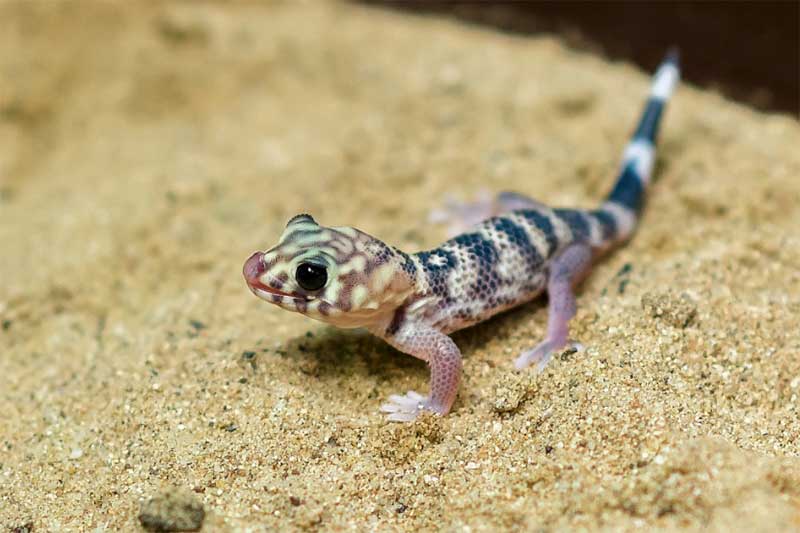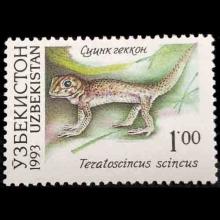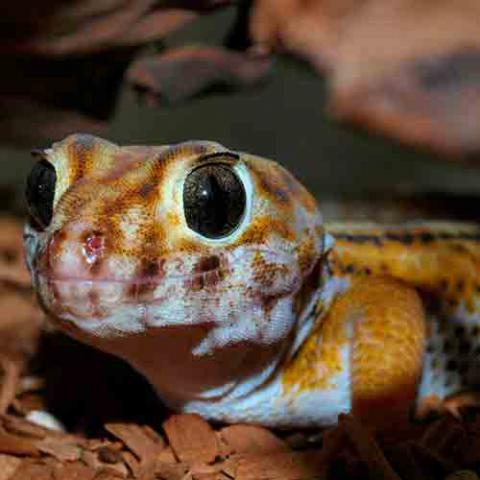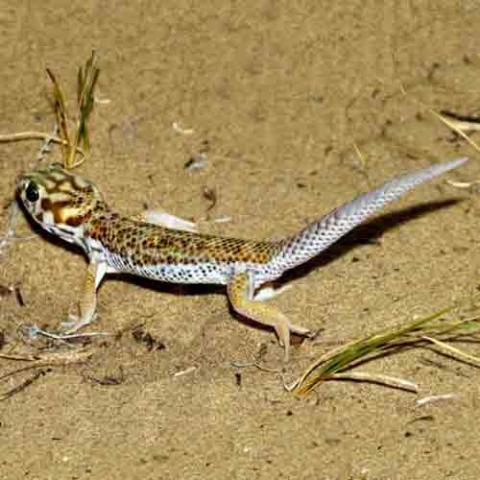NAMES
TAXONOMY
Uzbekistan
Issued:
Stamp:
Teratoscincus scincus
Uzbekistan
Issued:
Stamp:
Teratoscincus scincus
Uzbekistan
Issued:
Stamp:
Teratoscincus scincus
You can go to the Prague Zoo for the miraculous gecko
8/4/2016

Prague - This year, nine hundred cubs were born and hatched in the Prague Zoo. Among this less well-known, but no less interesting, is this year's four cubs of the miracle gecko (Teratoscincus scincus scincus). The miraculous gecko got its name not because it could cast a spell as a night sand elf, but because rubies (or to support Czech stones - grenades) shine instead of eyes when lit by a flashlight. Like snakes, he can't close his eyes because they are fused, immobile, and translucent - but unlike snakes, it gives him the appearance of a benevolent elf.
He can lick his eyes
He moistens large eyes with a slit-shaped pupil by licking them from time to time, which we breeders use when administering vitamins by placing a droplet on his eye, where a lizard licks it almost immediately, "says Nataša Velenská, reptile breeder.
In nature, miraculous geckos can be found from the Persian Gulf to China, in our zoo you can sometimes see them peeking out from under the rocks in the exhibition Kattakum (Pavilion of felines and reptiles).
At night, this species embarks on hunting and other wanderings, using a kind of comb on its fingers to move smoothly on the sandy surfaces of the desert and semi-deserts with sparse vegetation.
He likes beetles and locusts
Its prey becomes beetles and other insects, which in human care we replace crickets, cockroaches, locusts, etc. When it does not hunt, it walks on sand high on all four legs with its tail erect vertically like a saber, during the day it sleeps in deep to 80 cm long narrow burrows, where it likes to be in contact with a moist substrate.
When disturbed, it waves the tail rustling of peacock viper scales by waving its tail, and if caught, it can throw away not only the tail but also parts of the skin to escape the predator.
Temperature determines gender
Females usually lay two round parchment eggs, which harden on contact with air, of which striped chicks hatch after about 1.5-3 months, depending on the temperature - which determines the future sex of the gecko.
We use young and semi-grown individuals as hygienic police in desert and semi-desert terrariums. When their diurnal inhabitants stop activating, miraculous geckos come to the surface and select forgotten and uneaten insects after the daily shift.
Photo: Petr Hamernik, Zoo Praha.
Genus species (Animalia): Teratoscincus scincus
Teratoscincus scincus, also known as wonder geckos or, what I prefer, frog eye geckos. They are an orange yellow bodied with striping down the length of their bodies. The scales on their bodies almost resemble fish scales. Most notably are the huge eyes that give them that 'cute' look. They have been reported to live up to 20 years in captivity. This is not a quick gecko at all and can easily be trusted when working in their enclosures. They relate directly with sandy-rocky areas and take refuse behind - under the rocks for security. Size- around 6". They are nocturnal and almost never active during the day- to the point of being considered shy.
Range-Habitat
Teratoscincus scincus have a huge range- from the middle east to southern Asia to southern Russia. These geckos are terrestrial. They enjoy sandy habitats with rock groupings.
Care
Temperatures can range from 75 ambient temperature to a hot spot of around 95 degrees. While they prefer a more arid setup, they enjoy a misting of the enclosure once or twice a week. Provide larger overturned flower saucers for hides on both the warm side and the cool side. Offer sand around 2-3 inches deep as they do appreciate digging. A water dish (cleaned and refilled a couple times a week) can be used. Feedings can consist of crickets, mealworms, and dubias. Dust the insects with a calcium/vitamin mix every other feeding.
Breeding
Males and female can easily be kept together. The female places her eggs in the substrate and leaves them alone. Remove the eggs and place them in a bottle cap half filled with sand (to keep the eggs from rolling. Place the cap in a container with moist medium to keep the humidity. Incubate around 82 degrees. Eggs will hatch in about 60-80 days. Setup the babies like the adults, over sand with plenty of hiding places. Brumation should be provide with sufficient temperature drops in the winter.
Setup
Substrate- use a sand specific for reptiles- but do not use calci-sand, to about 3 inches deep. Use large overturned flower pot saucers and other hide material. Cork bark and other decor can be used in the enclosure as well. For breeding projects, a 10 gallon tank is sufficient for a pair.
Reference: www.supremegecko.com
Photos: http://animals-msk.ru, Klaus Rudloff, Berlin



